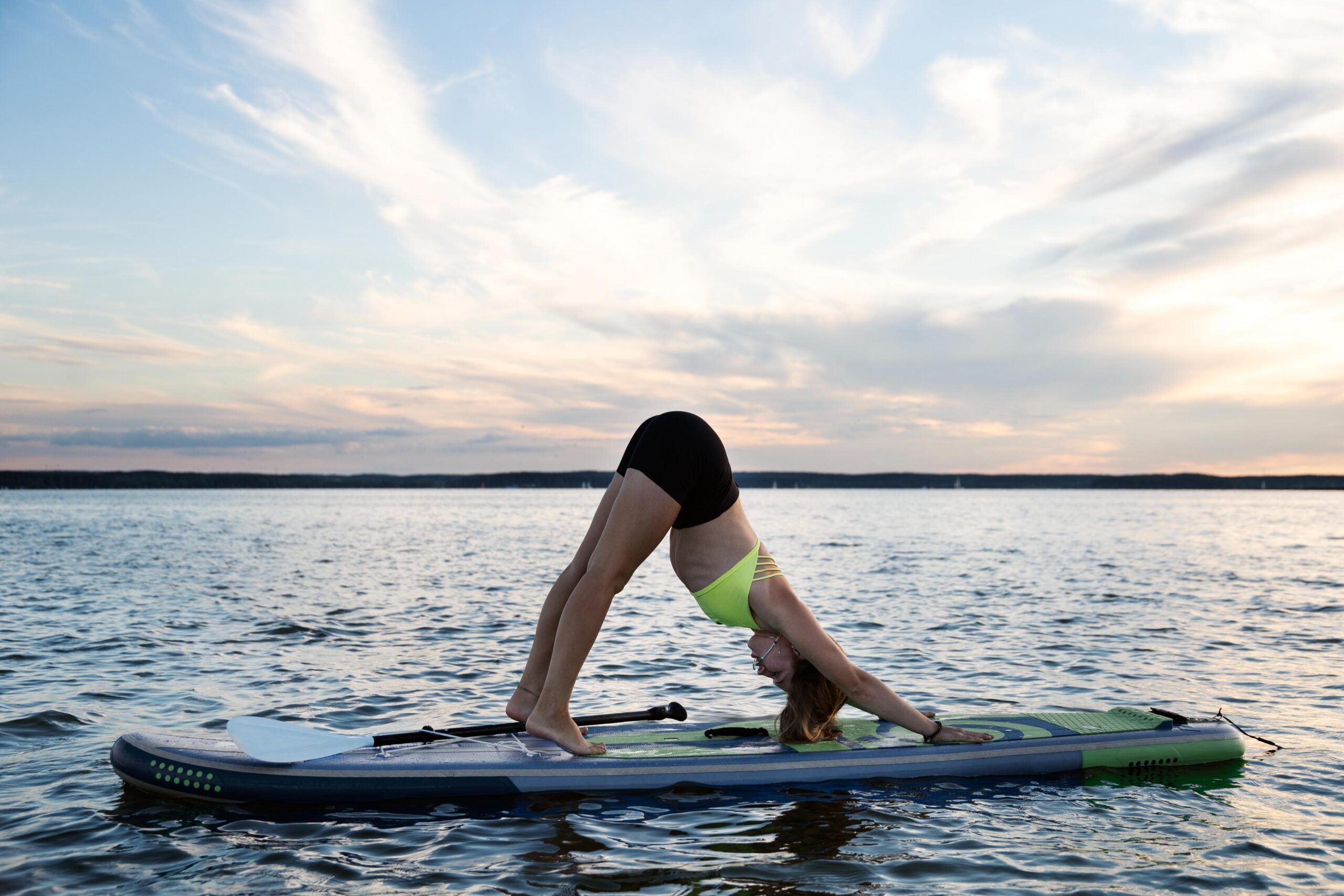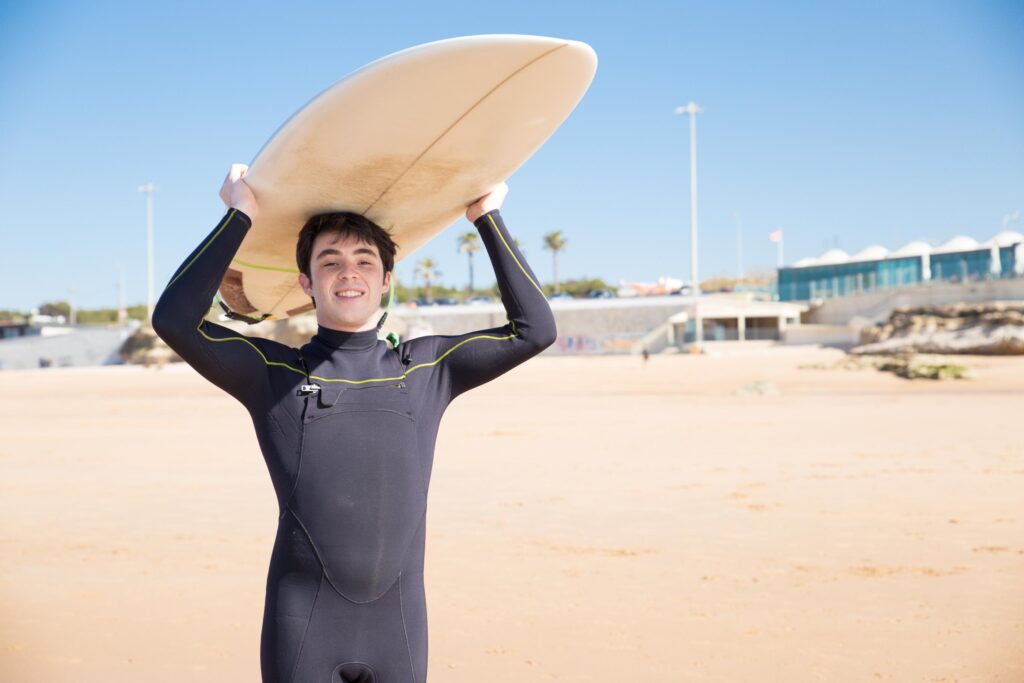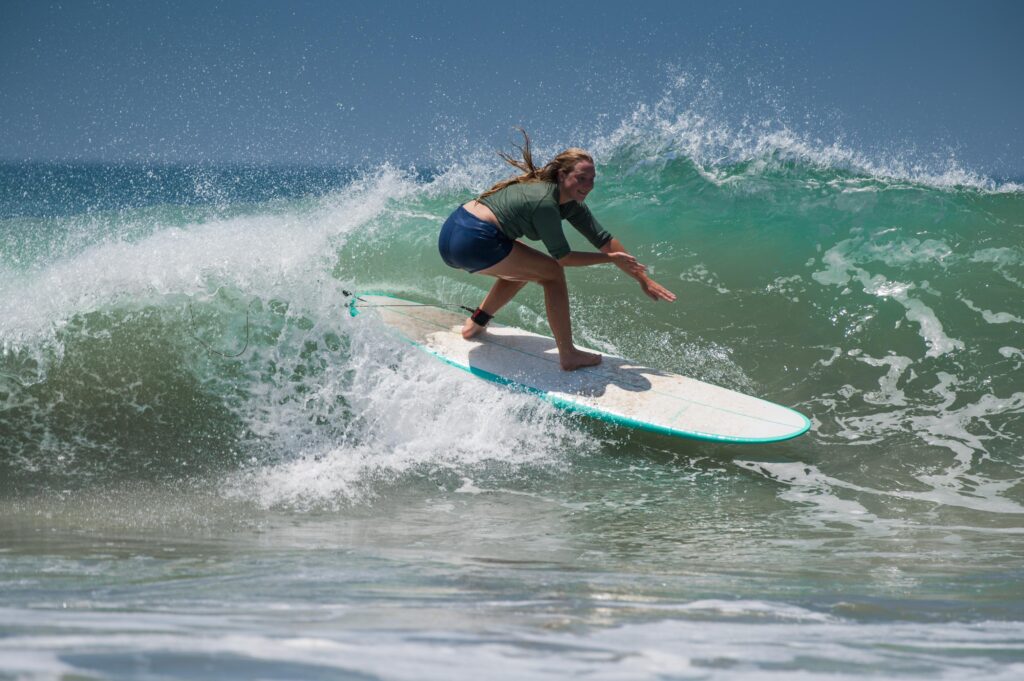Surfing is much more than an athletic activity. It’s a way of interacting with nature, a mix of balance, power, and aplomb.
However, surfing is more than just a technical ability; it requires an entire body that is sturdy as well as flexible and resilient.
The ocean can be unpredictable, and in order to face its obstacles, surfers have to be prepared both mentally and physically.
This is why land-based exercises come into the equation.
Suppose you’re a keen surfer trying to improve your performance or a novice eager to create an excellent foundation; an exercise routine that is targeted will make all the impact.
Why Do Surfers Need Strength and Flexibility?
Imagine paddling in a ferocious flow, surfacing at the top of your boat in one quick motion, then maneuvering around the force of a wave.
Every action requires coordination across several muscles.
The strength of your muscles allows you to paddle effectively, stay on the board, and recover after wipeouts, while flexibility lets you move with ease and avoid injury.
Surfers frequently face issues like tight hip flexors, weak core muscles, or a limited range of shoulder mobility.
These problems do not just hinder performance but can also increase the chance of injury.
Including workouts specifically tailored to surfing requirements can help tackle these weaknesses and build the endurance needed for long days in the water.
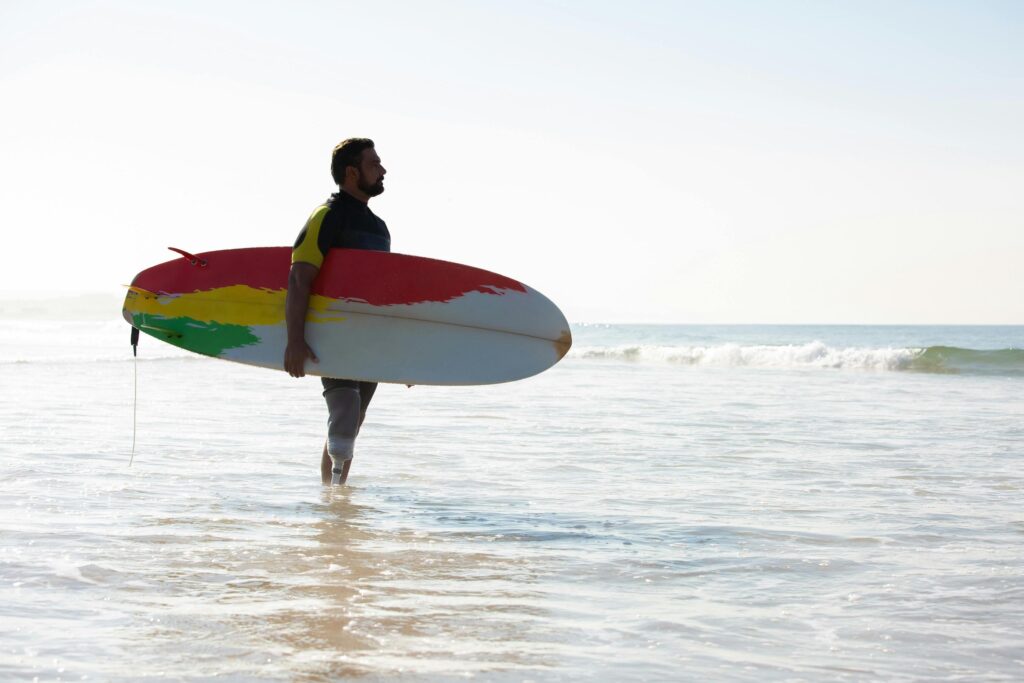
Building Strength for Surfing
1. Paddle Power: Upper Body Strength
Your shoulders, back, and arms form the engine that powers your paddling. Without strong muscles in your upper part, catching waves is an overwhelming task. To increase your power on the paddle:
- Push-Ups: An exercise classic that is akin to paddling. Different variations, such as wide-grip push-ups and incline push-ups, can target various muscles.
- Pull-Ups: It is excellent to strengthen the lats, which is a lot of work during paddling.
- Dumbbell: The rows Strengthen those upper back muscles that are vital to maintaining a smooth paddling position.
Professional Tip: Include resistance bands to mimic the resistance of water and add force.
2. Pop-Up Precision: Core Strength
The pop-up is an essential surfing skill that requires extreme power and stability. To master this skill:
- Plank variations From forearm planks to side planks This exercise helps build endurance within your core.
- Burpees They not only mimic the pop-up motion, but they replicate the pop-up movement but they also boost cardiovascular fitness.
- Russian Twists Engage your obliques for more control on your board.
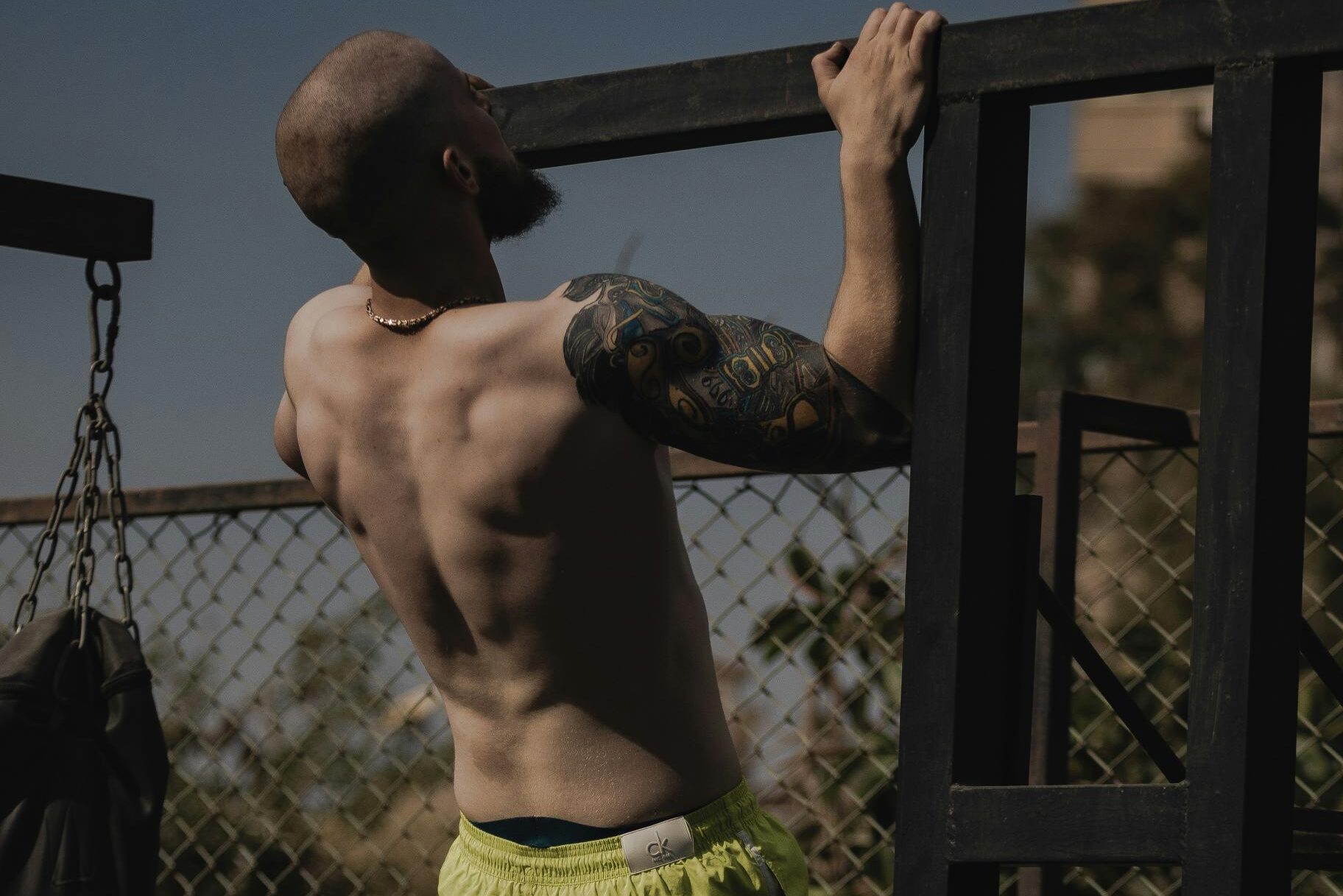
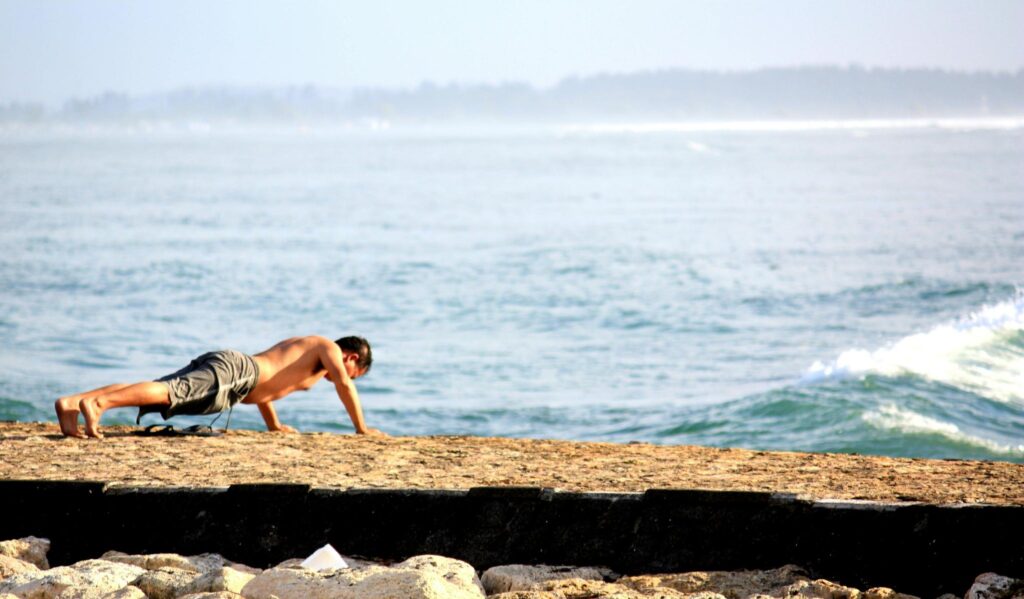
Enhancing Flexibility for Fluid Movements
Surfing is often a process of stretching, twisting, or reaching in a way that can test your flexibility. Flexibility doesn’t just mean being better, but also staying injury-free.
1. Dynamic Stretching
Before you hit the water, Active stretches will warm your muscles and increase blood flow. To help prepare your body, include movements such as arm circles or leg swings, as well as spinal rotations.
2. Yoga for Surfers
Yoga is the surfer’s secret weapon. Poses such as Downward Dog can stretch your hamstrings and shoulders, as Warrior II builds strength and balance.
Furthermore, Pigeon Pose assists in opening tight hips, which are a common problem for surfers.
3. Foam Rolling
A foam roller is a great way to relieve muscle tension and increase mobility. Focus on areas such as the shoulders, IT band, and lower back to relieve tightness and increase flexibility.
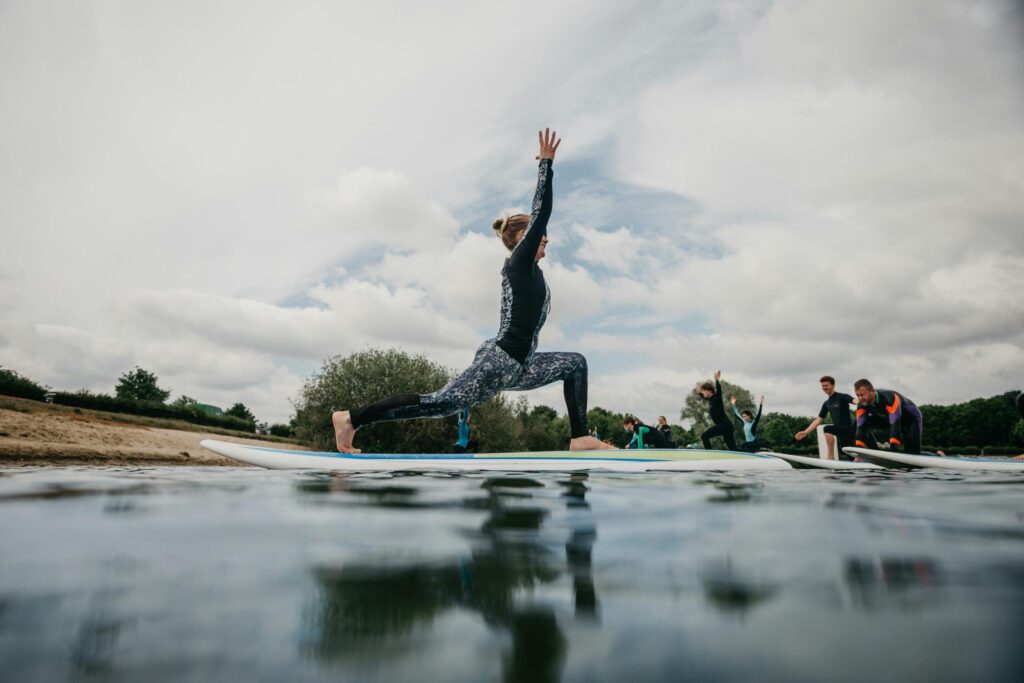

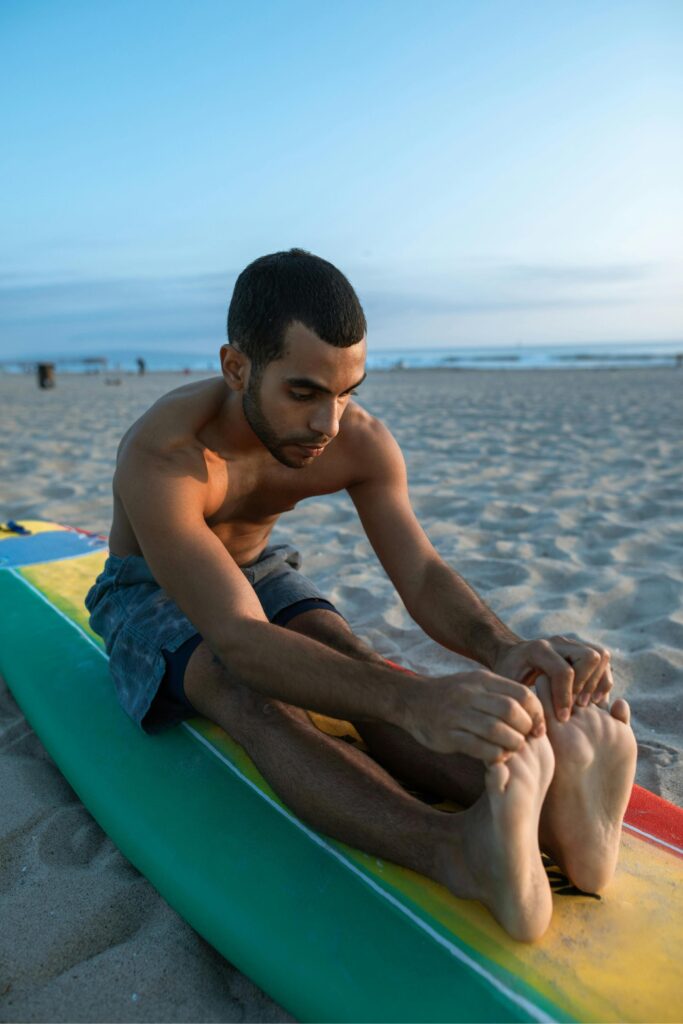
Advanced Exercises for Surfing Mastery
After you’ve mastered the fundamentals of flexibility and strength, adding more advanced exercises to your routine can improve your surfing abilities.
The exercises designed for this purpose mimic surfing motions and increase your ability to respond quickly and maintain balance. You can also endure longer sessions.
1. Balance Training: Stability on the Board
Balance is the most important factor in surfing. Rigid balance training will engage your stabilizer muscles, enhancing your ability to surf challenging waves.
- Bosu Ball Squats: Sitting upon a Bosu ball while doing squats will strengthen your legs and core, mimicking the sway of surfing.
- One-legged deadlifts: Concentrate on your muscles and balance, which will help you get back on track after landing wobbly.
- Indo Board Training The practice of movements on the Indo Board improves your reaction time and replicates the sensation of riding the wave.
Professional Tip: Combining balance workouts with strength training to create a dual-purpose exercise.
2. Plyometrics: Explosive Power for Take-Offs
Plyometric exercise builds explosive power, which is crucial for quick pop-ups and swift moves.
- Box jumps Increase lower-body strength and coordination. Make sure you are landing at a high level and gently to be safe from injuries.
- Skater jumps mimic the side-toside surfing motion while building leg strength and stability.
- Medicine Ball Slams: You can strengthen your shoulders, core, and back muscles, which are essential to creating force in turns.
3. Rotational Strength: Perfecting Turns and Maneuvers
The process of turning on a wave requires flexibility and strength in rotation. Training exercises that target your hips and obliques can aid in.
- Cable woodchoppers: Use a cable machine and resistance bands to replicate the twisting motion required to move the cable.
- Seated Russian Twists using Medicine Ball: Intensify your workout routine with weight.
- Landmine Rotations The compound motion strengthens your core and mimics the torso rotation that is used in carving.
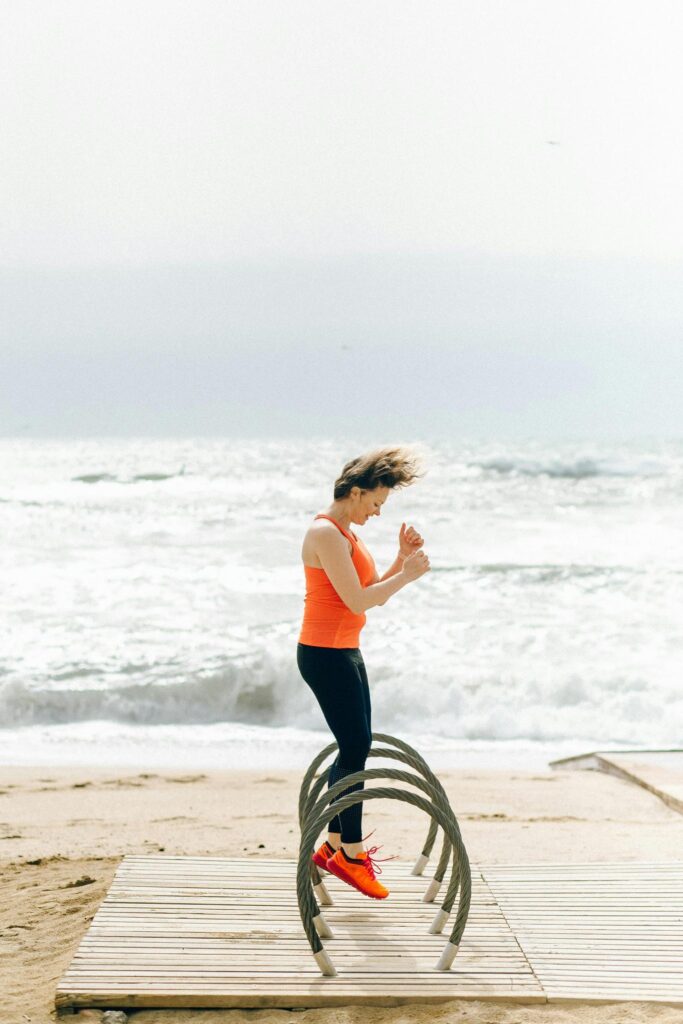
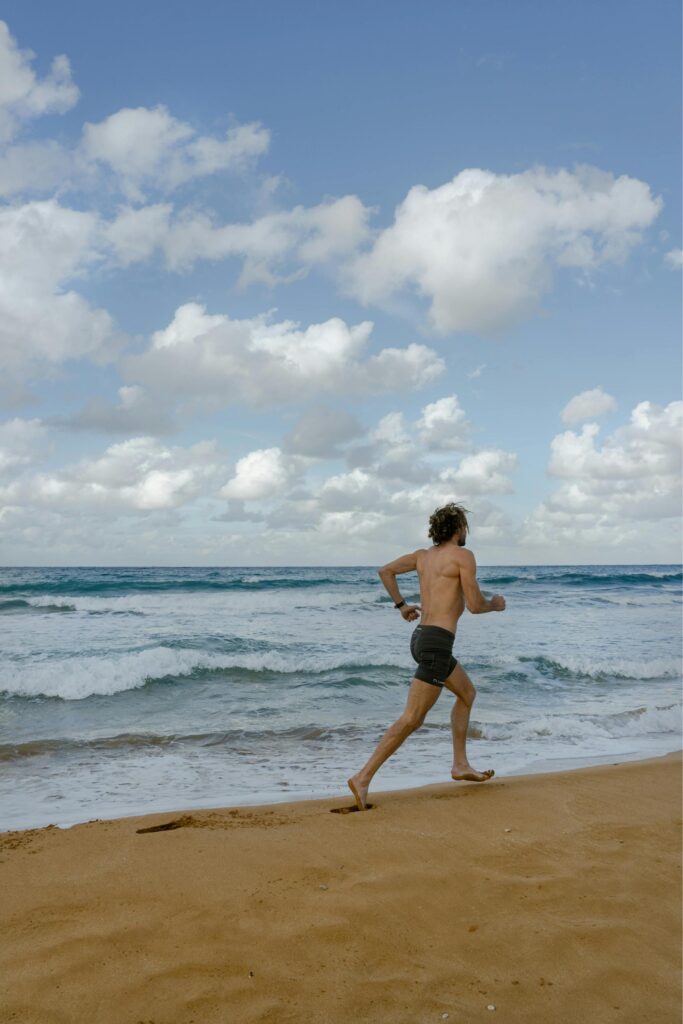
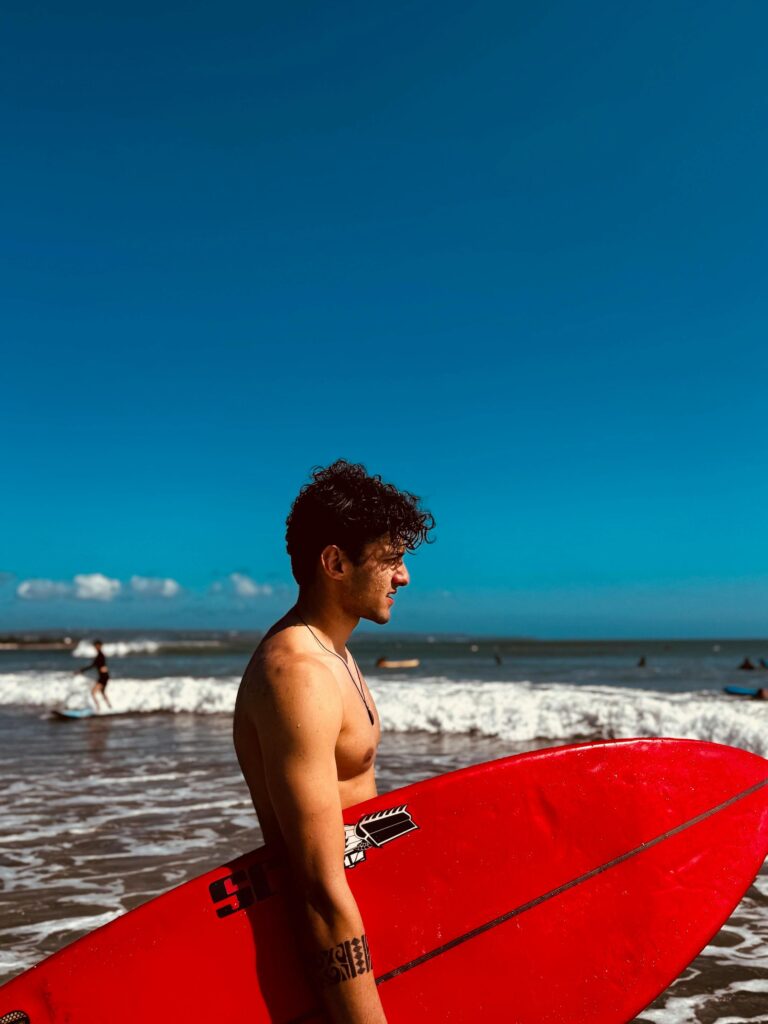
Recovery: The Unsung Hero of Performance
Surfing can be physically demanding, and the recovery process is often neglected. Proper recovery will ensure that your body is able to handle the next session without risk of injury or fatigue.
1. Post-Surf Stretching
After a surfing session, static stretching is a great way to stretch muscles that are in tension. Concentrate on your shoulders, lower back, hamstrings, lower back, and hips.
- Child’s Pose Releases tension in the back and shoulders.
- The Seated Forward Fold Flexes your hamstrings and lower your back.
- Supine Twist Improves spinal mobility and helps relax your core.
2. Hydration and Nutrition
Surfing energy and water deplete your body. Rehydrate with water and nutrient-rich snacks such as nuts, bananas, and protein shakes.
A balanced diet with lean protein, healthy fats, and complex carbohydrates helps boost muscle recovery.
3. Active Recovery
On days off, include light-hearted activities such as swimming, walking, or even yoga to improve blood circulation and help with muscle repair.
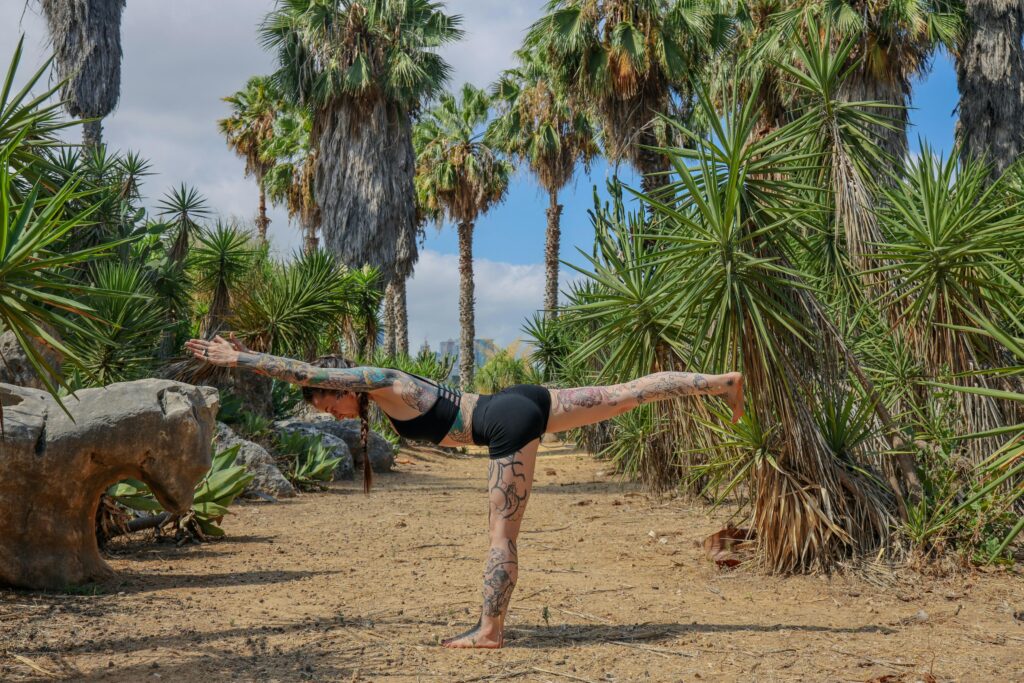

Crafting a Weekly Routine for Surfers
Making a plan for your workout specific to your needs is crucial to making your progress. Below is an example of a weekly schedule:
- Monday: Strength Training
The focus should be on your upper body and core workouts, including pull-up planks or dumbbell rows.
- Tuesday: Flexibility and Yoga
Spend this day focusing on dynamic yoga and stretching exercises that improve mobility.
- Wednesday: Balance and Plyometrics
Incorporate Bosu ball box jumps, squats or skater leaps.
- Thursday: Rest or Active Recovery
Select activities that are light so that your muscles can recuperate.
- Friday: Rotational Strength
Do exercises such as cable woodchoppers, and Russian twists.
- Saturday: Surf or Simulated Surf Training
Try paddling, pop-ups, and balance exercises.
- Sunday: Recovery and Foam Rolling
Concentrate on easing muscle tension and getting ready for the next week.
Overcoming Common Workout Challenges for Surfers
Maintaining a healthy routine isn’t easy, particularly when trying to manage surfing sessions as well as work commitments. Here are some strategies that can help you beat common obstacles and keep in the right direction.
1. Lack of Time
Between family, work, and online surfing, arranging a time to exercise can be a struggle. The key to success is efficiency.
- Solution Concentrate on low-impact, short workouts. A 20-minute HIIT session (High-Intensity Interval Training) or specific strength exercises are just as effective and efficient as more extensive exercises.
- Example: Mix push-ups, burpees, and planks into an exercise circuit for a complete body burn.
- Tip Plan your workouts as appointments. Consider them non-negotiable elements of your schedule.
2. Inconsistent Motivation
The motivation can fluctuate, particularly in winter or during times when progress seems slow.
- Solution: Set specific goals. Instead of setting a vague goal such as “get stronger,” try “improve my pop-up speed in 8 weeks.” Monitor your progress to keep you motivated.
- Tip: Visualize your success. Imagine yourself catching a brutal wave effortlessly due to your efforts.
3. Plateaus in Progress
It’s normal to reach an area where progress slows or ceases. Although it can be very frustrating, it’s an inevitable element of the fitness process.
- Solution: Mix things up in your routine. Introduce new exercises, raise weights, or explore different yoga postures to test your body in various ways.
- Tip: Review your performance. For instance, record the length of time you can hold a plank or the number of push-ups that you can complete in a minute, and strive to improve on these benchmarks.
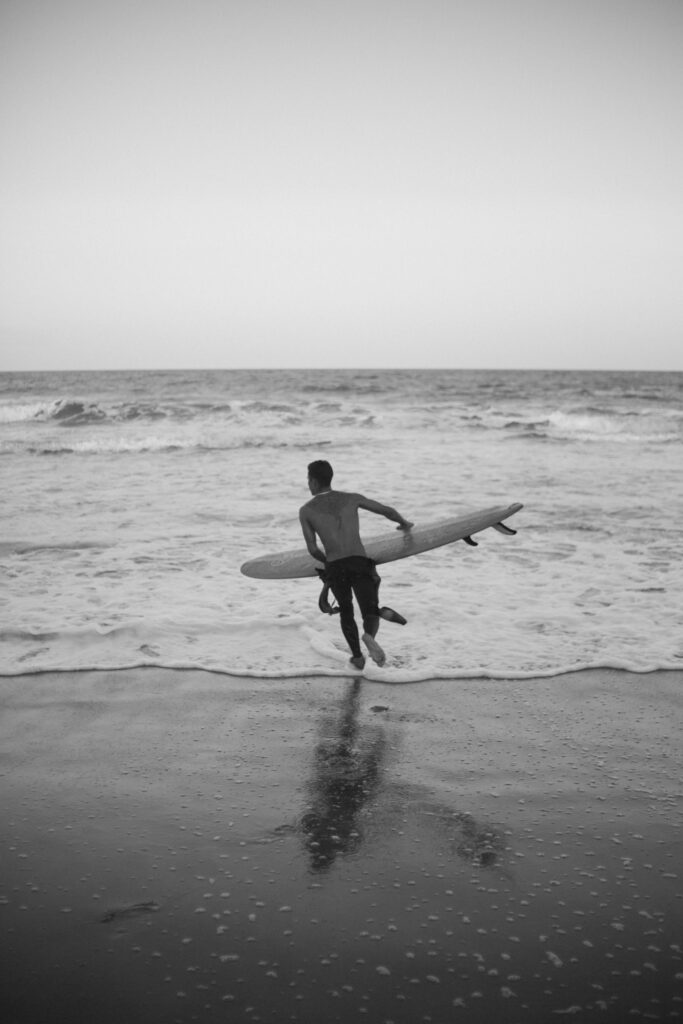
Motivational Tips to Keep You Inspired
Being motivated is essential for maintaining a consistent exercise routine. Here’s how to keep yourself motivated throughout your fitness journey:
1. Celebrate Small Wins
If it’s completing an exercise that you’ve never done before or feeling less tired when surfing, Be proud of your achievements. Small wins create momentum.
2. Join a community
Meet other users or fitness fans. Sharing workout tips, experiences, or even challenges encourage a sense of accountability and camaraderie.
3. Reward Yourself
Set goals and reward yourself each time you achieve them. For example, after one month of commitment to your plan, you can reward yourself with a new piece of surf equipment or a relaxing spa treatment.
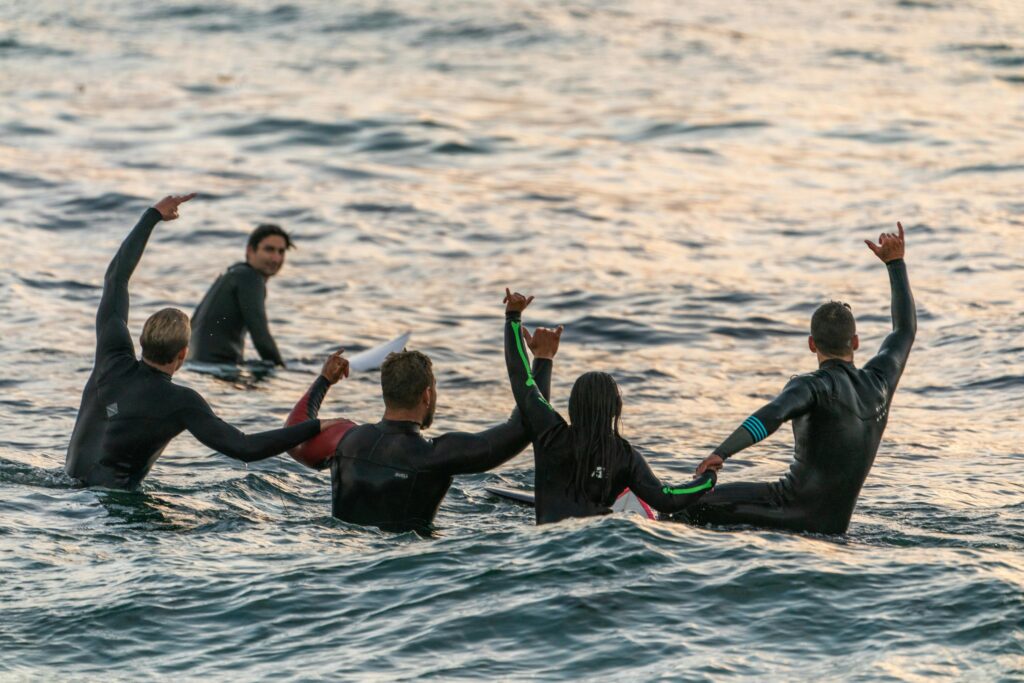
Building Mental Resilience for Surfing Fitness
Surfing requires more than physical strength; it requires mental strength as well. This is the same for your training.
Here’s how to build the mental toughness needed to remain disciplined:
- Visualization: Imagine yourself on the perfect wave, getting the confidence, energy, and strength from your training.
- Mindfulness: Include mindfulness practices, such as meditation or deep breathing, to help you stay focused and reduce stress.
- Positive Self-Talk Change negative beliefs (“I’m not enough strong”) with affirmations that empower you (“I’m improving each day”).
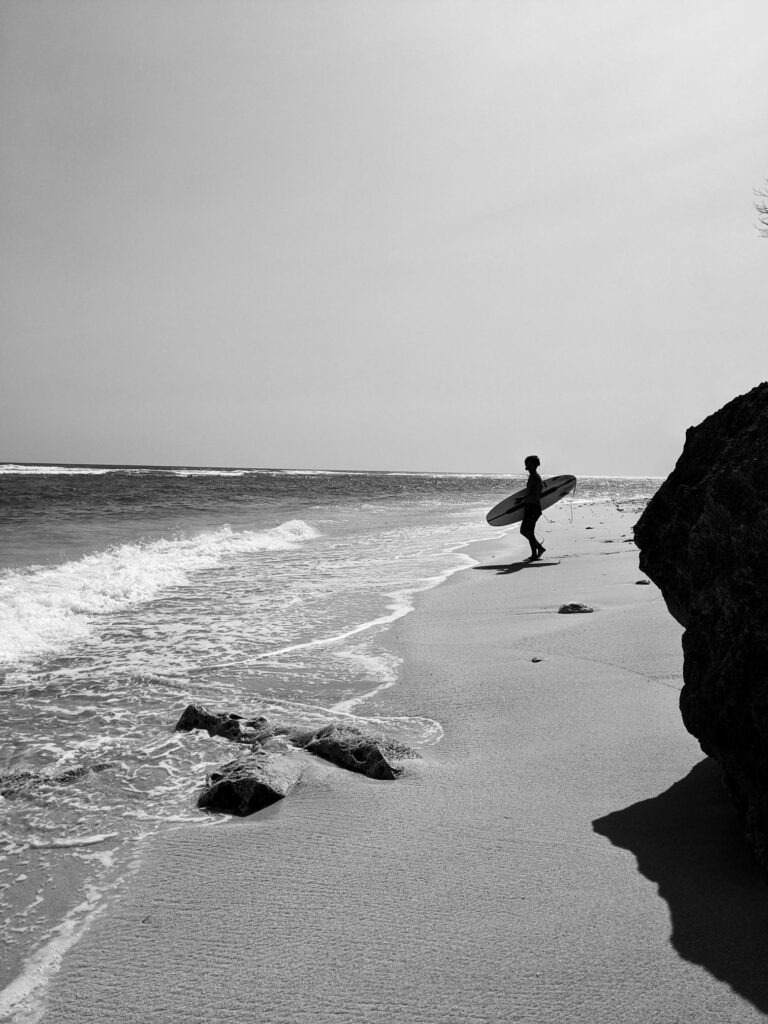
Conclusion: Ride the Wave of Progress
Surfing is just as much about preparation on land as it is on the water.
By focusing your time on strength, flexibility, and recovery exercises, you’ll be able to unlock new levels of fun and performance on the water.
Be aware that progress is a slow process. However, every step you take—whether it’s learning a new yoga posture, holding a longer plank, or feeling more stable on your board—brings you closer to achieving your objectives.
So, put on your trainers, grab your yoga mat, and prepare to develop your body and mind to be a surfer, always ready for every new wave.

